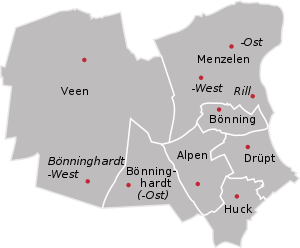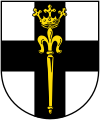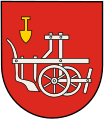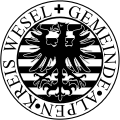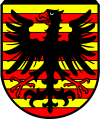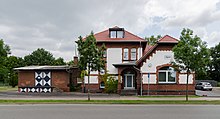Alps (Lower Rhine)
| coat of arms | Germany map | |
|---|---|---|

|
Coordinates: 51 ° 35 ' N , 6 ° 31' E |
|
| Basic data | ||
| State : | North Rhine-Westphalia | |
| Administrative region : | Dusseldorf | |
| Circle : | Wesel | |
| Height : | 25 m above sea level NHN | |
| Area : | 59.6 km 2 | |
| Residents: | 12,479 (Dec. 31, 2019) | |
| Population density : | 209 inhabitants per km 2 | |
| Postal code : | 46519 | |
| Area code : | 02802 | |
| License plate : | WES, DIN, MO | |
| Community key : | 05 1 70 004 | |
| LOCODE : | DE ALP | |
| Community structure: | 4 districts | |
| Address of the municipal administration: |
Rathausstrasse 3–5 46519 Alps |
|
| Website : | ||
| Mayor : | Thomas Ahls ( CDU ) | |
| Location of the municipality of Alpen im Wesel | ||
The municipality Alps is located on the lower Lower Rhine in the northwest of the federal state of North Rhine-Westphalia and is a kreisangehorige community of Wesel in the administrative district of Dusseldorf . It is a member of the Euregio Rhine-Waal .
geography
Spatial location
The municipality of Alpen is located in the Lower Rhine Plain , between Xanten (10 km) and Rheinberg (7 km) and 11 km southwest of the district town of Wesel , which is part of the Ruhr Regional Association. Parts of the Grenzdyck nature reserve are located in the northwestern municipal area .
Community structure
The municipality of Alpen is divided into four districts: Alpen, Bönninghardt , Menzelen and Veen .
Neighboring communities
The municipality of Alpen borders the city of Xanten in the north, the cities of Wesel and Rheinberg in the east, the city of Kamp-Lintfort and the municipality of Issum in the Kleve district in the south, and the municipality of Sonsbeck in the west .
history
The most important site for the early Middle Ages in the Alps is the Rill burial ground . However, early medieval graves from the 2nd half of the 7th century were also found in the Alps themselves, a little north of the town center.

Alpen was first mentioned in a document in 1074, but it may have belonged to the Archbishop of Cologne as early as the 7th century. Until about 1330 it was ruled by the family "von Alpen", first mentioned in 1084. By marriage, the rule came to the Electoral Cologne hereditary bailiffs from the family of the Lords of Heppendorf , who owned the place from 1330 to 1422 and then also called themselves von Alpen. The place received municipal rights from 1330 and was walled; later Alpen received the right to mint . The rule of the Alps remained in the possession of the Counts of Neuenahr until 1602 and then fell to the Counts of Bentheim until the French occupation (1794–1814) .
The Jewish community, which has existed since the beginning of the French era , used a synagogue mentioned from 1801 until it was destroyed in 1938. 56 tombstones (mazewot) from 1792 to 1936 have been preserved in the Jewish cemetery .
The Evangelical Church is the oldest Reformed parish church in Germany.
Castle Alps
The castle of the Alps , a moth with possibly two forecourts , was first documented to the 1200th The castle was inhabited until the 18th century. Made uninhabitable by an earthquake in 1758, the buildings eventually crumbled. In 1809 the moth was removed and the material used to build a Chausseestrasse (Burgstrasse) laid out under French occupation . This road cuts the western part of Moth Hill. At the end of the Second World War , citizens of the Alps built an air raid shelter in Mottenhügel. In the period that followed, the castle grounds became overgrown. In preparation for the 900th anniversary of the Alps, the hill was restored in 1972-74. Trees were planted on the castle hill one year before the NW Monument Protection Act came into force. Since the 1980s, the plant overran again. As part of an urban redevelopment program, the Motte Alpen has also been redeveloped since 2018. The recovery of the ground monument is a project of the European Year of Cultural Heritage 2018 (Sharing Heritage) of the European Commission .
Ortisei
The original church of St. Ulrich is mentioned for the first time around 1300 in the Liber valoris , but may date from the 11th century because of the patronage. In the Middle Ages it was located west of the city in front of the “church gate”. It was destroyed in a war in 1602 and the new parish church was built within the city in 1650.
Territorial reform
In pre-revolutionary times, the Alps belonged to the Rheinberg Office of the Electorate of Cologne , which was added to the Kingdom of Prussia at the Congress of Vienna in 1815 . Then, in the course of the Prussian administrative organization, the Alps came to the Rheinberg district on April 23, 1816 as one of 29 districts in the Jülich-Kleve-Berg province , later the Rhine province , which was, however, united with the Geldern district in 1823 . This association was reversed in 1857. From then on, the Alps belonged to the district of Moers .
On April 1, 1939, the communities of Bönning , Bönninghardt , Drüpt , Huck and Millingen were incorporated into the Alps.
On July 1, 1969 in the first phase of been restructuring in North Rhine-Westphalia communities Alps, Menzelen and Veen of the former Office Alpen-Veen together Alps for the new community.
As part of the Lower Rhine Act , the Millingen district was reclassified from Alpen to the city of Rheinberg on January 1, 1975 and the municipality of Alpen was assigned to the new Wesel district.
politics
City council and mayor
According to the results of the local elections on May 25, 2014, the 32 seats in the municipal council are distributed among the individual parties as follows:
|
Mayor of the municipality of Alpen, who is also a member of the municipal council, is Thomas Ahls (CDU). He was elected in 2009 with 83.1% of the valid votes and confirmed in office in 2014 with 63.5%.
Coat of arms, banner and seal
The coat of arms of the extinct Lords of the Alps depicted a standing, right-facing crowned red lion in a silver shield covered with an iron hat .
The municipality of Alpen was granted the right to use a coat of arms , a banner and a seal with a certificate from the District President of Düsseldorf dated January 14, 1971 .
| Blazon : " Divided eleven timesby gold (yellow) and red , topped with a red armed black eagle ." | |
| Justification of the coat of arms: The coat of arms is based on that of the former Electoral Cologne hereditary bailiffs and Lords of the Alps, the Counts of Neuenahr , and on the coat of arms of the Lords of Heppendorf zu Rheydt and Alpen. The symbols already appeared in the city's oldest seal from the 15th century, depicted at the feet of a bishop with a book ( Ulrich von Augsburg as the patron of the Alps ) within a magnificent Gothic portal . |
|
|
Description of the banner: "Stripes eleven times from yellow to red, topped with a red-armored black eagle pushed up a little over the middle."
Description of the seal: “The municipality has an official seal with the inscription: + GEMEINDE.ALPEN.KREIS WESEL + (in the form of a coin legend). Seal picture: In the black circle divided eleven times from white to black, covered with a black eagle. " |
Infrastructure and economy
Transport infrastructure
Rail transport
The station Alpine is located about 500 meters east of the town center at the Niederrhein route ( KBS 498 ) on which the rail passenger transport , the regional train "of the Lower Rhine" (RB 31) Xanten - Moers - Duisburg wrong.
Local rail passenger transport is carried out by the NordWestBahn (NWB), which uses LINT 41 diesel multiple units in single and double traction.
In addition, Alpen still owns the disused Menzelen West station , which was once the junction of the Lower Rhine route and has now been disused from Haltern to Venlo . It has not been used since 1978.
Transportation
Alpen is connected to the local transport network by several bus routes. These are all connected to the regional train line via the Alpen Bf stop or the Bf branch . An express bus (SB7) connects the Alps with the district town of Wesel and Geldern . Other bus routes run to the surrounding communities. There is also a citizens' bus in the Alps. The bus routes are operated by the Niederrheinische Verkehrsbetriebe (NIAG) and by Regionalverkehr Niederrhein (RVN).
The tariff of the Verkehrsverbund Rhein-Ruhr applies to all local public transport (ÖPNV) and the NRW tariff applies to all tariff areas . The tariff of the Bürgerbus Alpen is excluded . The ticket is only valid for the journey from the Alps to Veen via the Bönninghardt or back.
Streets
Alpen is connected to the federal highway 57 ( E 31 ) as well as to the federal highway 58 and the federal highway 57 . At the same time, the municipal area is cut through by highway 460 (north) and highway 491 (in the south-western area). There are other roads too.
Companies
Larger companies in the Alps are the agricultural machinery manufacturer Lemken , the company Norgren GmbH (IMI Norgren), which produces pneumatic controls there, and the rental of work platforms Mateco , formerly Gardemann. The Volksbank Niederrhein is based in Alps.
safety
The municipality of Alpen has a voluntary fire brigade with around 100 members and 14 emergency vehicles that are housed at the Alpen, Menzelen and Veen locations. The federal motorway 57 in the direction of Rheinberg and Sonsbeck is also part of their area of operation . The rescue service is ensured by an ambulance stationed at the DRK rescue station at the train station and the rescue stations in Rheinberg and Xanten. The Wesel district police authority maintains a district official who has been in the new town hall building since 2010. The fight against crime is ensured by the police stations in Xanten, Rheinberg and Kamp-Lintfort. In 2010, the E57 civil protection sirens , which have been in various locations in the municipality for many decades, were replaced by new high-performance sirens to ensure that the population was warned.
education
In Veen, Menzelen and Alpen there is a primary school, in Alpen there is a secondary school based on the model of the North Rhine-Westphalian state government located near the historic Motte.
Sports
In the area of the school center in Alpen there is a multi-purpose gym , a swimming pool , several soccer fields and tennis facilities. There are sports facilities in all parts of the village that are used by the local clubs and schools.
Sports clubs in the municipality:
- Athletics Community of the Alps V.
- FC Viktoria Alpen 1911 e. V.
- BSV "Rot-Weiß" Bönninghardt
- SV Menzelen 1925 e. V.
- SV Borussia Veen 1920 e. V.
- BSV Drüpt 1683 e. V.
- DLRG OG Alps
- Riding and driving association "St. Georg “Alpen e. V.
- ASV "Rotfeder" Alps
- Pokerteam-am-Niederrhein
- Aikido Dojo Alpen e. V.
Personalities
- The Electress Amalia , Countess Palatine near the Rhine, Duchess in Bavaria , née Countess zu Neuenahr and Limburg , Frau zu Alpen etc. was born in 1539 at the castle in Alpen and died there on April 10, 1602. First she was with the leader of the Dutch freedom movement, Heinrich von Brederode , later with the Elector Friedrich III. married from the Palatinate .
- Johann von Alpen (1630–1698) was vicar general of the diocese of Münster .
- Paul Hachenberg (1642–1680), legal scholar, historian and politician
- Wilhelm Brinkhoff (1839 – after 1860), robber on the Bönninghardt
- Wilhelm Koppers (1886–1961) priest, ethnologist. From 1928 professor of ethnology in Vienna. As a supporter of Austrofascism he had to leave Austria after annexation to Germany. After 1945 he was hired again.
- Hans-Hermann Jansen (* 1960), musician, educator and university professor
- Anne Gesthuysen (* 1969), journalist and presenter of the ARD morning magazine .
- Robert Bongen (* 1974), author and television journalist for the ARD political magazine Panorama .
- Marc Torke (* 1982), moderator a . a. at Mitteldeutscher Rundfunk , now at Radio NRW .
See also
swell
- Burgsteinfurt. Schloß, II. Rep. A. 4. Electoral Cologne leanings ... b) Dominion Alps and IV. Rep. G. 3. Neuenahrsche inheritance a) Neuenahr, Alpen, Helpenstein, Bedburg, Hackenbroich, Brederode, Lennep, Mörs) and c) Dominion Alps. In: Ludwig Schmitz-Kallenberg (edit :): Inventories of the non-state archives of the Steinfurt district (= publications of the Historical Commission of the Province of Westphalia. Inventories of the non-state archives of the Province of Westphalia. 1,4). Aschendorff, Münster 1907, pp. 59–61 and 131–133 (= pp. 547 * –549 * and 619 * –621 *) ( digitized version of the University and State Library of Münster).
- Günter Aders (edit.): Documents and files of the Neuenahr lordship and possessions of the Alps, Bedburg, Hackenbroich, Helpenstein, Linnep, Wevelinghoven and Wülfrath as well as the hereditary bailiff of Cologne (= inventories of non-governmental archives. 21). Regional Association of Rhineland, Cologne 1977.
literature
- Arbeitsgemeinschaft Alpen-Lexikon (Ed.): Alpen-Lexikon. From A… like an adventure playground to Z… like a draw well. Old and new features from our community in brief descriptions. 2005.
- Walter Bösken: History of the Protestant community in the Alps. 1929.
- Joachim Daebel: Electress Amalia von der Pfalz and her church in the Alps 1604-2004. 2004, ISBN 3-7954-1716-3 .
- Alfred Noss : The coins from Jülich, Mörs and Alps . Kress & Hornung, Munich 1927.
- Friedhelm Okken: The Alpener Grafhaus in the Reformation period. 1993.
- Scheren, Funke (Ed.): 325 years of bachelor rifle clubs in the Alps, 325 years of village community. 2007.
- Hans-Georg Schmitz (Hrsg.): Alps (festival book for the 900th anniversary). 1974.
- Peter Schmitter: History of the Alps Jews. Alpen 1986, ISBN 3-9801378-0-5 , p. 147 (documents from the beginning of the Alps to the path of suffering in the Nazi era).
Web links
- Website of the municipality of Alps
- Entry on the Jewish cemetery in the Alps in the " KuLaDig " database of the Rhineland Regional Council
Individual evidence
- ↑ Population of the municipalities of North Rhine-Westphalia on December 31, 2019 - update of the population based on the census of May 9, 2011. State Office for Information and Technology North Rhine-Westphalia (IT.NRW), accessed on June 17, 2020 . ( Help on this )
- ^ Regional Association Ruhr: District Wesel. October 9, 2017, accessed February 8, 2018 .
-
↑ W. Bösker: ancient finds at Alps. In: Bonner Jahrbücher . 104, 1899, p. 119. -
Frank Siegmund: Merovingian time on the Lower Rhine (= Rhenish excavations. Volume 34). Rheinland-Verlag, Cologne 1998, ISBN 3-7927-1247-4 , p. 271. - ^ Theodor Josef Lacomblet: Document book for the history of the Lower Rhine. Volume I. Düsseldorf 1840, p. 141 f. No. 218.
-
↑ Like Bonn, Pingsdorf, Lechenich, Jülich, Kempen, Neuss and Zons, the Alps had an alms pledge to maintain according to a provision which, according to tradition, can be traced back to Archbishop Kunibert (600–663 AD). In addition: Friedrich Wilhelm Oediger: The Regests of the Archbishops of Cologne in the Middle Ages Volume I. Bonn 1954, No. 46. -
Friedrich Wilhelm Oediger: The oldest churches on the Lower Rhine. In: The Gold-Blue Book of Geldrischer Geschichte. Festschrift for the centenary of the Historical Association of Geldern und Umgebung e. V. Kevelaer 1951, p. 37 f. - ^ Georg Dehio , edited by Claudia Euskirchen, Olaf Gisbertz, Ulrich Schäfer: Handbuch der deutschen Kunstdenkmäler. North Rhine-Westphalia I Rhineland. Deutscher Kunstverlag, 2005, ISBN 3-422-03093-X , p. 77.
- ^ History. In: kirche-moers.de, accessed on May 5, 2018.
- ↑ Michael Müller-Wille: Medieval castle mounds ("Motten") in the northern Rhineland. Supplements Bonner Jahrbücher Volume 16, Cologne / Graz 1966, p. 28 No. 21.
- ^ Theodor Josef Lacomblet: Document Book for the History of the Lower Rhine Volume I. Düsseldorf 1840, p. 567. The document mentions a castellanus de Alpheim, the moth only implicitly.
- ^ Bernfried Paus: Kasteel von Alpen. A tomb of history awakens. In: Rp-online.de . March 8, 2018, accessed on September 22, 2018 : “Alps. After clearing the moth, archaeologists are currently examining the ground monument carefully. Your findings will make the basis for ambitious plans, the historic place to life. " .
- ↑ Erwin Kohl: Alps: Institute records motte three-dimensionally. In: RP.online. April 4, 2018, accessed on September 22, 2018 : “Alpen. The lens of a scanner will measure the distance from 60 different points of view. A virtual terrain model is then created on the computer. "
- ↑ Sharing Heritage - European Cultural Heritage Year 2018. In: sharingheritage.de. Pausanio GmbH & Co. KG, Cologne, accessed on September 22, 2018 (published before September 9, 2018).
- ↑ Friedrich Wilhelm Oediger (Ed.): The Archdiocese of Cologne around 1300. Issue 1: Der Liber Valoris (= publications of the Society for Rhenish History XII. Explanatory Notes on the Historical Atlas of the Rhineland. Volume 9.1). Bonn 1967, p. 73, No. XII, 2.
- ^ Friedrich Wilhelm Oediger: The churches of the archdeaconate Xanten. Bonn 1969, p. 108 f. with note 3.
- ^ Official journal for the administrative district of Düsseldorf 1938, p. 209
- ↑ Martin Bünermann: The communities of the first reorganization program in North Rhine-Westphalia . Deutscher Gemeindeverlag, Cologne 1970, p. 103 .
- ↑ Martin Bünermann, Heinz Köstering: The communities and districts after the municipal territorial reform in North Rhine-Westphalia . Deutscher Gemeindeverlag, Cologne 1975, ISBN 3-555-30092-X .
- ↑ State Returning Officer NRW: Local elections 2014 - Final result for the Alps
- ^ Regional Returning Officer NRW: Mayoral election 2014 - final result for the Alps
- ↑ Cf. the eight ancestral coats of arms of Werner V. von Pallant († around 1609), great-grandson of Adriane von Alpen († 1502/07) to Zelem and that of Hubert Lothar von Gertzen called Sinzig, from Theodor Graminaeus: Description of their Fürstlicher Güligscher & c. Wedding. Gras, Cologne 1587 ( digitized version and digitized version from the Bavarian State Library in Munich), ( preview and preview in the Google book search).
- ↑ See coins of the rule of the Alps. In: Hermann Grote (Hrsg.): Münzstudien. Vol. II. Hahn, Leipzig 1862, pp. 781-788 and pp. 1007 f. in Google Book Search.
- ↑ See Toni Diederich: Rheinische Städtesiegel. Neusser, Neuss 1984, pp. 164-168, especially p. 166.
- ↑ Hans Coop man, Willi Jansen, Fritz Art: Alpener villages in old pictures. Geiger, Horb am Neckar 1999, ISBN 3-89570-514-4 , p. 2.
- ↑ Cf. (with interpretation of the Archbishop of Cologne as feudal lord) Karl Gautsch, Ludwig Clericus (arrangement): J. Siebmacher's great and general book of arms. Bd. I, 4.2 city arms. 2nd edition Bauer & Raspe, Nuremberg 1885, p. 264, doi: 10.11588 / diglit.29230 # 0154 , digitized version of the Heidelberg University Library. On the coin image of the white penny from the Alps (see above), Peter is depicted with the key as the patron saint of Cologne Cathedral in a church portal.
- ↑ See Klemens Stadler: German coat of arms. Vol. VII: The municipal coats of arms of the federal state of North Rhine-Westphalia. Anglo-Saxons, Bremen 1972, p. 18.
- ^ Main statute of the municipality of Alpen . alpen.de. Retrieved March 12, 2017.
- ^ Hermann Habben: Coats of arms, seals and flags in the Moers district. Rheinberg 1962, p. 48.
- ↑ Querying the course book route 498 at Deutsche Bahn.
- ↑ Sports offer in the Alps. In: alpen.de, accessed on May 5, 2018 (PDF).


